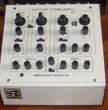
Oberheim Four Voice ad, circa 1978
A groundbreaking analog synthesizer introduced by Oberheim in 1975; it is considered the first polyphonic synth to use voice allocation methods (preceded by the extremely expensive and rare Yamaha GX-1). The Four Voice consisted of four Oberheim SEM expander modules mounted in a case with a scanning keyboard (licensed from E-mu) and circuitry that handled the voice allocation, and a an audio mixer that combined the audio outputs of the four SEMs into a composite audio out. When a key was played, the voice allocation module received a code from the keyboard, and from that it chose a SEM to play the note. It then generated CV/Gate signals to the chosen SEM to play the note. The SEM and scanning keyboard were units that Oberheim already had in production, which allowed them to get the Four Voice on the market with minimal additional engineering.

Original version SEM, installed in stand-alone case, Courtesy Yves Usson @ yusynth.net
The Four Voice had an unusual degree of patching flexibility since each of the SEMs included its own voice parameter controls. However, this also caused a significant problem especially for live performance: in order to change to a different patch, particularly if it was desired that all voices sound the same (which would normally be the case when playing a polyphonic synth), then it was necessary to change the patch controls on all four SEMs, a lengthy and error-prone process. So in 1976, Oberheim introduced a programmer module. The programmer connected to expansion connectors inside the SEMs and used this to inject control voltages for the parameters that were voltage controllable. This gave the programmer control over most (not all) of the parameters of the SEMs. Controls on the programmer duplicated the SEMs' controls and allowed a parameter to be changed on all four SEMs simultaneously with a single knob. Additional, the programmer had patch memory and could store parameter settings for 16 patches. This considerably simplified the task of patching the Four Voice and made it a more practical instrument. The patch memory capability was very advanced for the time.
Two variants of the Four Voice were offered. The Two Voice was a stripped-down model with a smaller case that could accommodate two SEMs; it also included a small sequencer. Since the programmer module was built to accommodate eight voices, Oberheim offered an expansion cabinet for the Four Voice that could hold up to four additional SEMs; this later became incorporated into a larger case and named, naturally, the Eight Voice. (A very small number of Eight Voice units, possibly six, were built in a dual-manual version; see below.) The series was made up until about 1980, when Oberheim began introducing more integrated polyphonic synths.
Because each SEM is a complete monophonic synth in its own right, many of the Four Voice series synths have since been broken up. At one time it was not uncommon for a collector to buy a Four Voice, remove the SEMs, sell them individually, and then scrap the other parts. For this reason, not many complete Four Voice or Eight Voice systems survive, and the remaining ones are highly sought after. However, in 2009, Tom Oberheim formed a new company, TomOberheim.com, and began making new SEMs. In 2013, the company began offering the Two Voice Pro, an updated version of the original with a much-enhanced sequencer, MIDI interface, and velocity and aftertouch sensing keyboard. It also includes a large number of patch points, making it a semi-modular. A version of the Two Voice Pro is available in black, including SEMs with black panels and white graphics. Oberheim at one time was advertising a new Four Voice version to be called Son of Four Voice, but as of 2017 this has not appeared.

A two-manual Eight Voice that once belonged to Peter Wolf, and is now on display in the Musical Instrument Museum in Phoenix, Arizona USA. All eight SEMs are in the expansion cabinet at the top; to the left of each row of SEMs is a mixer module. The programmer is at the upper left of the base cabinet. Each manual has a portamento and mode control panel to its left. Note the lack of pitch or mod wheels.